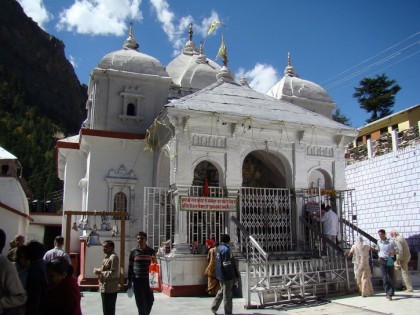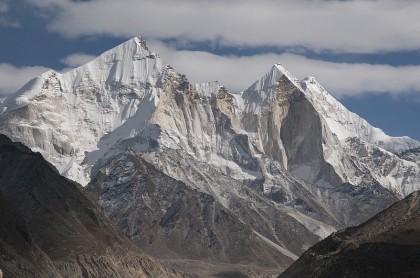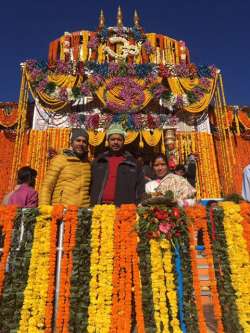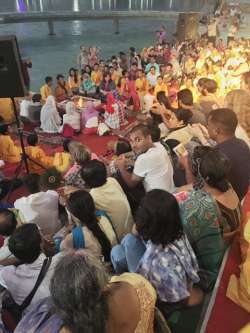
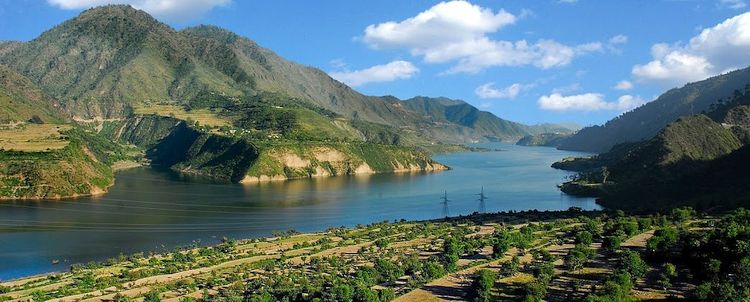
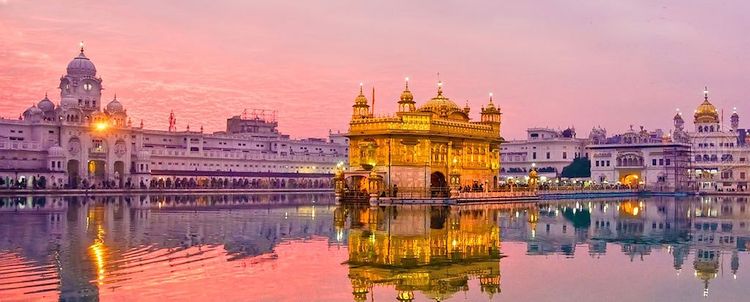
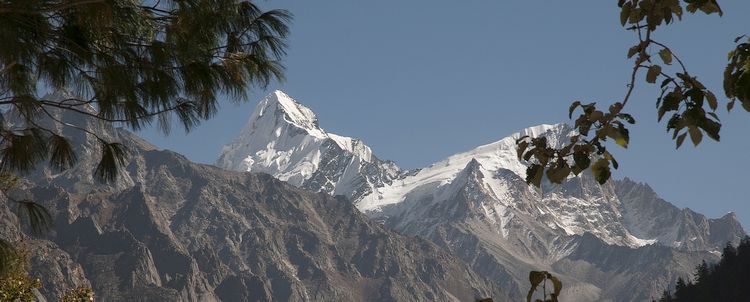
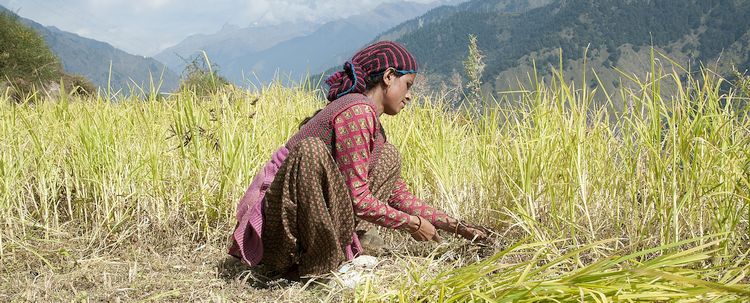
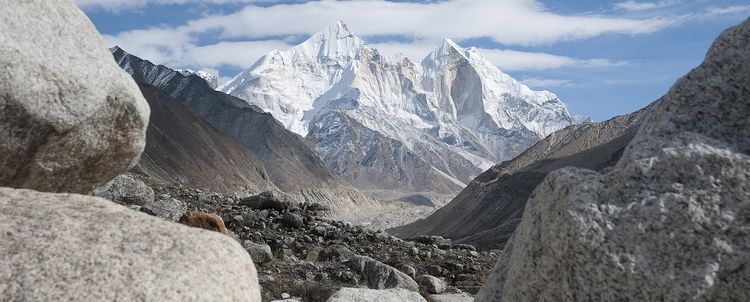
Garhwal and Kumaon in Uttarakhand – Impressive Diversity of Hindu culture
Best Travel Period | Uttarakhand in Brief | Peoples and Religions | Food | Flora and Fauna | National Parks and Nature Reserves | Mountain Scenery and Trekking | History | Economy | Festival Calendar
Uttarakhand is an Indian state in the mountainous north of the Republic, which is divided into the administrative divisions Garhwal and Kumaon. Bordered by the provinces of Himachal Pradesh and Uttar Pradesh, as well as by the neighboring countries of Nepal and Tibet, some magnificent, snow- capped mountain regions of the Himalayas open to the visitor here, and some of the most sacred places of the Hindus. Western tourism has not much developed in the State so far, mainly pilgrims on the paths of Hinduism are traveling up the Ganges to his springs in Garhwal, which are here revered as sacred. The spring rivers of the Ganges, the Alaknanda and the Bhagirathi unite in Devprayag and raise the small town into an important Hindu pilgrimage site with the typical stairs, carved into the rocky shore to the holy river.
Anyone who would like to plunge into the Ganges and who wants to feel the liberating, and according to the legend healing properties of its water, can still do this here without hesitation - because so close to its source in the Himalayas, it is still clear and clean. Attend a Hindu purification ceremony in Gangotri or visit one of the many yoga schools in the region for a short training or a multi-day retreat, allow yourself to be pampered according to Ayurvedic tradition in a luxurious Ashram in Rishikesh, or follow us on the paths along the alpine pastures through pine and birch forest, to impressive vantage points in the Himalayas.
Also Garhwal and Kumaon live from the diversity of the landscape and the culture, and the language of the population, like so many regions in India, Nepal, Tibet and Mongolia. Kumaon for example brought forth several seemingly overwhelmingly powerful warriors, which were respectfully observed by the British colonial, the Kumaon regiment under Indian domination is famous to this day for the courage and honor of its soldiers. However in the villages and on the roads one encounters friendly eyes and smiling faces, and can enjoy as a traveler the extraordinary hospitality of the people.
We also build your bridge into the fascinating city of Rishikesh, in which both historical and modern temples are nestled to the banks of the Ganges. We enable, if you wish, the contact to Hindu Yogis who will teach you, and to traditional yoga schools, and we walk along with the shepherds of the bharal - sheep herds over the rich green, or in the spring, colorfully blossoming alpine pastures. Experience responsible and sustainable tourism in cooperation with the village communities of the Himalayas, the alpine flora and fauna in its diversity, and the colorful homage of the Hindus to their gods.
Best Travel Period for Uttarakhand
In Uttarakhand, the monsoon rules in the summers from about June onwards and brings lots of precipitation, so that one should avoid the months from June to September as a travel time window. For trekking and ascents to great heights even the cold season is not optimal. However, basically one can also discover Uttarakhand during the winter on a trip, and admire the beauty of the unspoiled countryside. Absolutely ideal and very suitable for all travel plans is the spring, from late January to May you can watch the awakening of nature, observe the local people in the lowlands during their sowing and use all trekking routes. The Months of October and November are absolutely also recommended for travel, the monsoon has left the country, leaving behind lush greenery.
Uttarakhand in Brief
| Location | In northern India in the Himalayas, with southern and western border to the states of Himachal Pradesh and Uttar Pradesh, western border to Nepal, northern border to Tibet (China). |
| Area | 53.483 km² |
| Population | 10.086.292/ 189 pro km² (2011) |
| Capital | Dehradun |
| Districts | 13: Dehradun, Haridwar, Tehri Garhwal, Uttarkashi, Chamoli, Pauri Garhwal, Rudraprayag (division of Garhwal) as well as Almora, Bageshwar, Champawat, Nainital, Pithoragarh, Udham Singh Nagar (division Kumaon) |
| Topography | In the south, the Ganges plain, at an altitude of only 300-400 m above sea level. To the north the land rises then over the foothills of the Himalayas up to the peak of the Nanda Devi with 7816 meters of altitude. |
| Vegetation | Subtropical vegetation in the Ganges plain, which changes according to the height of the ascent right up to alpine vegetation. Accordingly large plant diversity: subtropical trees, bamboo, ferns, orchids and magnolia, mixed forests of beeches, oak and chestnut trees, and rhododendron. In the valleys of a moderate altitude an impressive number of flowers, up to 1000 different species bloom at the same time. On high altitudes a wide variety of alpine (healing) herbs and grasses. |
| Wildlife | As wide as the variety of vegetation is also the diversity of wildlife: From elephant, rhinoceros, bears and tigers in the lowlands (which are only to be found in conservation areas) a surprisingly high number of birds will delight ornithologists, to the presence of snow leopards , yaks and many sheep and goat species in the high places. In addition, reptiles, amphibians and insects in large numbers. |
| Climate | Subtropical continental climate with summer monsoon. |
| Temperatures | Maximum values throughout the year between 28 and 35 ° C, at night cooling down to 18 ° C. Per 100 m rise above sea level a reduction in the temperature by about 0.5 to 1 ° C must be expected. |
| Rainfall | Overall, more than 2000 mm of rainfall per year, of which 80% in the months of monsoon from June to mid-October. |
| Languages | Hindi (almost 90%) with Kumaoni and Garhwali as major dialects, Urdu, Punjabi, Bengali, Nepali. |
| Ethnicities | In the lowlands and in the low mountain ranges are living mainly members of the higher Hindu castes, Brahmins and Rajputs. In the high mountains on the other hand, there is a multitude of tribes which are considered to belong to the Bothia and the Lepcha, and which are of Buddhist faith. Furthermore live in Uttarakhand descendants of Pakistani tribes as well Bengalis and Nepalese. |
| Religions | Above all Hinduism (85%), 12% Islam, 2.5% Sikhs. |
| Economy | The population is for the most part engaged in agriculture and livestock breeding, but covers with it mainly its own needs, due to the difficult conditions. Tourism is an important source of income. |
| Getting there | From Delhi by train and car. |
| Visa / Entry permit | For the entry to India, a passport which is valid at least another six months and a visa are required. |
| Vaccinations | Apart from the standard vaccinations, immunizations against hepatitis, typhoid, rabies, meningococcal meningitis and Japanese encephalitis are recommended. |
Peoples and Religions
The population in Uttarakhand is ethnically quite uniform in comparison to some other regions in the Himalayas. On the coast and in the low mountain ranges live mainly Brahmins and Rajputs, which means Hindus of higher castes, additionnally some Bengalis and Punjabis who had immigrated shortly after the end of the British occupation. Only in the high mountain ranges the typical minority mosaic is found, which is consisting of many small tribes with Tibetan and Nepalese origin. In accordance with their respective ancestral history is also the religious affiliation of the people: almost 85% of the population are practicing Hindus, people originating from the Punjab are often of Muslim faith.
In the high mountain ranges one comes across practicing Buddhists, whereby their religion is frequently pervaded by Hindu influences. Very rarely the "pure" Tibetan Buddhism is being practiced, just as there are only a few small tribes which are attributable to shamanism. Since there are important Hindu places of pilgrimage in Uttarakhand (especially the sources of the Ganges are sacred) Hinduism is represented succinctly throughout the state. As important Hindu pilgrimage site in the area of Uttarakhand are especially well known Devprayak and Gangotri - highly recommended stations during your stay.
Food
The food supply in Uttarakhand is varied all year now, thanks to the reliable import of fruits and vegetables nowadays, compared to the times when the population supported itself solely by eating the crops which they had grown themselves. The staple food is here, as in the rest of India, definitely rice, which is often cooked as a curry with different ingredients. Also found in the cooking vessels of Uttarakhand is the typical Indian stew made from pulses, Dhal. Everywhere in the streets of the cities small food stalls are seemingly always open, where you can obtain a meal or a snack at a low cost.
Especially in late summer the offer of freshly harvested tropical fruits like oranges and mangoes is very tempting. But it is important to not consume unpeeled or uncooked fruits and vegetables - often the gastrointestinal system of Western tourists is quite susceptible to here perfectly normal bacteria. Since the people of Uttarakhand are predominantly Hindus, relatively little meat is found on the menu plan of the people by the way. But in hotels and restaurants one does get it, and also the offers on our journeys are based entirely on your personal preferences.
Flora and Fauna
An India holiday in Uttarakhand and especially a trekking tour through its pristine landscapes let the heart of every plant and animal lover soar higher. The variety of species of trees, flowers, ferns, grasses, insects, mammals and birds seems limitless, and with each step you will discover a new world. The orchids, which are blossoming colorfully in the low-lying forests in spring, but also the flowering meadows in the valleys of the low mountain ranges are intoxicatingly beautiful and the scent of countless flowers completes the enjoyment. Everywhere the travelers encounter colorful butterflies, in the hills some shepherds move about with their flocks, and in the national parks one has the chance to observe various species of animals in danger of extinction.
National Parks and Nature Reserves
The Jim Corbett National Park in the Nainital district in the southern part of Uttarakhand was founded in 1936, making its approximately 520 km² to the oldest protected area ever in India. Here one can still find populations of the Bengal tiger, as well as the Indian leopard, and watch with a little luck a herd of Asian elephants. Moreover live here rhesus monkeys, the cute Asian palm civet Paradoxurus hermaphroditus as well as collar and sloth bears, the Indian mongoose, jungle cats, spotted deer, sambar deer, nilgai antelope and many more.
Even swamp crocodiles are represented, in addition to 580 different species of birds. Adjacent, and with 820 km² area by more than one-third bigger, is the Rajaji National Park. It includes the Shivalik hills landscape and houses across the various vegetation zones of its conservation area a similar flora and fauna as the Jim Corbett National Park. Here lives one of the largest known populations of Asian elephants.
Also the Valley of Flowers belongs to the protected areas. It extends over three vegetation zones and is home to dense forests with very typical vegetation, but also with extraordinarily rare trees such as the Himalayan maple Acer caesium. In addition, the plant lovers can also find 500 different species of flowers (already 62 different plants of the aster family), countless lower developed plant species and various medicinal herbs, some of which were found exclusively here.
Regularly the Valley of Flowers is searched for further discoveries, and scientists from around the globe are conducting intensive research on the possibilities offered by the use of medicinal herbs to Western medicine. Visitors are welcomed by the scent of wild roses and wild strawberries that line the paths. Of course also the animals enjoy the protection of the region, 13 endangered mammal species like the Himalayan black bear Ursus thibetanus or the Himalayan musk deer Moschus lecogaster live here.
Not far from the Valley of Flowers is the reserve of Nanda Devi National Park, which includes not only the mountain with the same name, but around 70 other peaks in the surrounding areas. However, a trek in this sanctuary is always subjected to the risk that the current protection decisions prohibit for example the crossing of a particular mountain pass, and the route has to be varied accordingly. But the biodiversity of the region, the incomparably beautiful panoramas and the dazzling mountain views make the attempt in any case worthwhile!
Mountain Scenery and Trekking
The Mountain scenery of Uttarakhand particularly stands out thanks to its pristine beauty. There is no mining, very few people are settled here and even shepherds are rather rarely found. From the gentle hilltops, which are covered in lush green and speckled by colorful flowers, one has an overwhelmingly beautiful view in all directions, to the north always against the stunning backdrop of the white peaks of the Himalayas.
| Physical challenge | Description and area of the trek | Maximum altitude | Duration | Type of accommodation | Notes / Description |
|---|---|---|---|---|---|
| TREKKING 3600 – 4800 meters | |||||
| moderate to demanding | Nanda Devi East Base Camp | 4200 meters | 14 days | tent | This trek crosses the valley of Milam. The river Milam and also the river Pindar are supplied by the same glacier, which was formed on the slopes of the mountain peaks Kohli and Trishul. The route to the base camp at Mt. Nanda Devi East opens the superb panoramic views of its eastern side. Previous experience in trekking at high altitudes must be there. |
| moderate to demanding | The source of the Ganges | 4500 meters | 9 days | Mountain cabins, tent | A comfortable, only moderately demanding trek to the source of the Ganges. The ascent to the Tapovan however is then definitely challenging. Prior experience in trekking at high altitudes must be there. |
| MOUNTAINEERING above 5600 meters | |||||
| moderate | Mt.Baljuri Kumaon | 5922 meters | 12 days | tent | Trek over Loharkhet - Dhakuri - Khati - Dwali - base camp and trying to climb the summit. Enjoy the viev of the summit of the Nanda Khat, Changuch and Nada Kot, pass crossing Longstaff Col and Nanda Devi East. |
| moderate | Mt. RontiGarhwal | 6063 meters | 12 days | tent | Trek over Debal – Sutol – Sitel - Homakund (BC) - Ronti , trying to climb the summit over the Ronti-saddle. Enjoy the view of the peaks of Trishul, Nanda Ghunti, Neelkanth, Chaukhamba and Kedarnath. |
History
Uttarakhand is a very young state of the Republic of India, which was created by splitting it off of the territory of Uttar Pradesh only in the year 2000, and it first existed (until 2006) under the name of Uttaranchal. Current seat of government is Dehradun, the city is located in the division of Gharwal at an average altitude of 680 m above sea level. From a historical perspective were in the area for many centuries the two peace-loving kingdoms Kumaon and Garhwal, until at the end of the 18th and at the beginning of the 19th century first the Nepalese Gurkha, and then the British invaded the region and put the territory under their control.
Economy
As usual in many Himalayan regions, the majority of the population is involved in agriculture, but thereby the people are covering almost exclusively their own consumption. In the lower regions rice can be cultivated, at higher altitudes grow potatoes, millet, vegetables and apples. Livestock is being bred there, especially in the high mountains, in the small settlements of the indigenous tribes. Even this mainly serves self- sufficiency. Tourism though is absolutely a respectable source of income for Uttarakhand, because in addition to a few Western tourists, a relatively large number of Hindu pilgrims are flowing in into the region along the Ganges, past the place where the confluence is in Devprayag, upwards to its source rivers, to make a pilgrimage to its origin, and to perform a ceremonial purification. The government of Uttarakhand operates the promotion of this tourism in a sustainable manner, and ensures the involvement of the population and the protection of the landscapes.
Festival Calendar
In Uttarakhand, the Hindu and Buddhist festivals and holidays are being celebrated according to their respective rites and traditions. These are based calendrically on the lunar cycle, which is why they fall on different dates each year. Due to a comparatively high proportion of Muslims in the population, corresponding events are also held at high Muslim holidays. But particularly attractive for tourists are certainly the Hindu celebrations, which are being observed almost all year round, because of the many holy sites in the state - in particular the washing ceremonies on the banks of the Ganges and its source rivers Alaknanda and Bhagirathi are sacred, and exalt even those which are only watching. We gladly councel you about the participation in Hindu ceremonies or Buddhist ceremonies during your travel time window!

